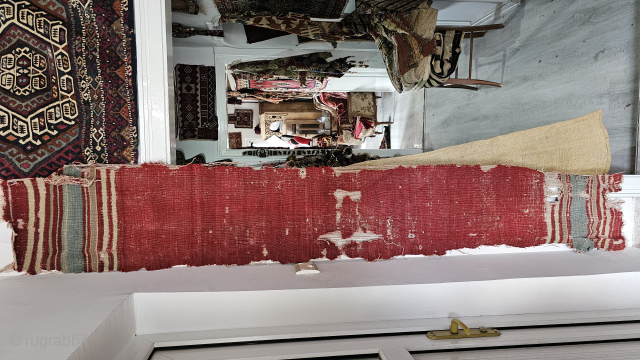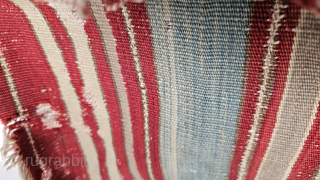Back
Size ; 35 x 213 cm
West anatolia, Manisa
Early 1800...
The tradition of carpet and kilim weaving in Manisa is thought to have begun in the 14th century, when Turks settled in the region, and spread in the 15th and 16th centuries. Manisa carpets, exported to Europe, particularly in the 17th and 18th centuries, held great commercial value. These weavings, also used in Ottoman palaces and mansions, were renowned for their fine craftsmanship. Today, this tradition continues as a vibrant cultural heritage, particularly in regions like Yuntdağ and Gördes.
Gördes, one of the most important regions that comes to mind when talking about Manisa weaving, is renowned for the type of knot known as the Gördes knot, known worldwide as the Turkish knot. Carpets woven in this region, especially prayer rugs, experienced a golden age in the 17th and 18th centuries, standing out for their excellence in material, color, and pattern.
Characteristics of Manisa Kilims
Manisa kilims have unique characteristics. Primary colors such as dark blue, dark red, and beige are generally used.
price:
Ask
- Home
- Antique Rugs by Region
- Category
- Profiles
- Post Items Free
- Albums
- Benaki Museum of Islamic Art
- Budapest: Ottoman Carpets
- Gulbenkian Museum
- Islamic Carpets. Brooklyn
- Islamic Textiles. Brooklyn
- Konya Museum: Rugs
- MKG, Hamburg
- MMA: Caucasian Carpets
- MMA: Mamluk Carpets
- MMA: Mughal Indian Carpets
- MMA: Ottoman Carpets
- MMA: Safavid Persian Carpets
- MMA: Turkmen Rugs
- McCoy Jones Kilims
- Ottoman textiles. Met
- Philadelphia Museum
- Rugs and Carpets: Berlin
- Seljuqs at the Met
- TIEM, Istanbul: Carpets
- V&A: Classical Carpets
- Vakiflar Carpets: Istanbul
- Baluch Rugs: Indianapolis
- Gallery Exhibitions
- Jaf an Exhibition
- Alberto Levi Gallery
- Andean Textile
- Christie's London: 2016
- Francesca Galloway
- HALI at 40
- ICOC Washington, DC 2018
- Jajims of the Shahsavan
- London Islamic Week April, 2018
- Mongolian Felts
- Navajo Rugs: JB Moore
- Persian Piled Weavings
- SF Tribal & Textile Art Show 2020
- SF Tribal 2019
- Sotheby's: C. Alexander
- Turkish Prayer Rugs
- Turkmen Main Carpets ICOC 2007









